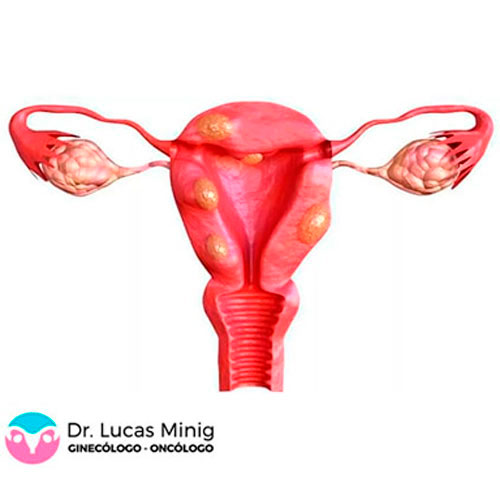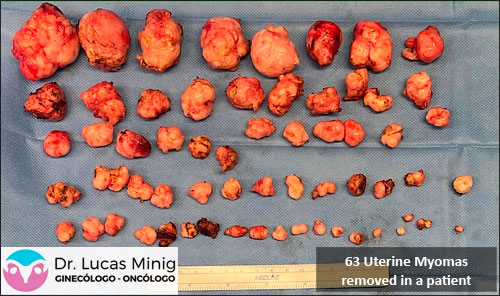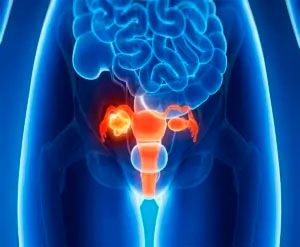Uterine Myomas and Fibroids
Request a quick appointment with the specialist in Uterine Myomas, Dr. Lucas Minig, an expert Gynecologist Oncologist in this type of cancer that is very common in women.
Appointment: Click to Request an Appointment for ovarian cancer in Spain.
Contact: +34 679 112 179
Get to know the CV, Training and Biography of Lucas Minig.
What are Myomas and Fibroids?
Myomas are rounded and solid non-cancerous growths, also known as benign tumors or fibroids because of their fibrous and hard consistency. Myomas originate from the uterine muscular wall and form from muscle fibers, they can be single or multiple and generate from hormonal stimuli.
Therefore, myomas disappear after menopause. Uterine fibroids are very common and can affect up to 30% of women between 30 and 40 years old
Who suffers from myomas?
Myomas are the most common benign tumors in women, with an incidence close to 70%. Most of them are asymptomatic and it is usual for one patient to have multiple myomas.
What causes uterine myomas? Why do myomas appear?
Consequently, the causes of uterine myomas are genetic and hereditary, the action of sex hormones that accelerates the abnormal growth of muscle cells in the uterus.
How are myomas diagnosed?
The diagnosis of uterine myomas is made through a physical examination and gynecologic sonography (abdominal and transvaginal) which detects the situation and number of fibroids and can diagnose more than 90% of them
Specialist in Uterine Fibroids
Dr. Lucas Minig in Valencia, Spain
Are you looking for a specialist in uterine fibroids?


The factors that influence the appearance of myomas are:
Do you need a second opinion about treating fibroids?
Symptoms of myomas
Most women are asymptomatic. They are detected and diagnosed in the periodic gynecologic evaluation that women should undertake. When symptoms appear, they depend on the size and location of the myoma, and in general terms, they can cause:
- Heavy menstrual bleeding: Abnormal bleeding caused by myomas inside the uterine cavity, which make menstrual bleeding heavy and long (menorrhagia) and bleeding between periods (spotting). On occasion, these myomas can be pushed out causing contractions similar to those during labor, dilating the cervix with intense pain; this is what we call prolapsed myomas.
- Uterine bleeding between periods
- Chronic pelvic pain: Pelvic pain is caused either by a myoma pressing nearby organs (gut, bladder, etc) or by the lack of blood flow in voluminous and fibrous myomas
- Urinary or fecal urgency
Types of myomas:
There are different types of fibroids and they are classified according to their location, depending on how close or far they are from the endometrium. Below we define the types of fibroids:
Subserosal
the ones that grow on the outer layer of the uterus. They are usually bigger and can reach, on rare occasions, up to 20 – 30 cm. Even though most of them do not cause symptoms, they can cause difficulty in urination and/or defecation or a pelvic pressure sensation as they grow.
Intramural
The ones that grow inside the uterine wall. They share a lot of features with subserosal myomas. Nevertheless, heavy menstrual bleeding tends to be one of the most characteristic symptoms of this type of fibroid.
Submucosal
The ones that grow inside the uterine cavity. In this case, they are not usually large (2-3 cm), but they can cause infertility and uterine bleeding between periods in some women.
What is the treatment of uterine myomas?
The treatment of uterine myomas is not often necessary in most women. This is because they are generally small and do not cause any type of symptoms. However, the treatment of a uterine myoma must be contemplated in some cases when they reach a large size, or cause one of the symptoms previously cited.
The treatment of uterine myomas varies according to:
- Size and location
- The severity of the symptoms it causes
- The presence or absence of coexisting conditions that contraindicate the pharmacological treatment, mainly hormonal ones.
pharmacological treatment of myomas (conservative treatment)
- Analgesic treatment: in some cases, myomas can cause different pain levels or pelvic discomfort that can be in fact, the reason why they are diagnosed. In case there are no other symptoms present and given a small size of the myoma, analgesics are indicated to relieve pain while monitoring after a few months is undertaken to confirm that the myoma is not growing.
- Treatment with drugs to control bleeding: there are specific drugs that can be administered to women with very heavy bleeding and only on the days of greater blood loss. Effectiveness is limited but they can be a conservative option for the treatment of uterine fibroids.
- Treatment with contraceptives: Hormonal treatment for myomas has been used for a long time. Nevertheless, it is mainly indicated in women with very heavy menstrual bleeding due to myomas. Even though it is not always effective, it can be tried before resorting to more invasive treatments.
Hormonal treatment can be administered through different routes. The most commonly used options are either combined oral contraceptives (estrogen and progestin) or local administration through a hormonal IUD (MIRENA).

- Treatment with Urlipristal acetate (Esmya ®): Esmya has been extensively used in the treatment of myomas since 2010 when it was first commercialized. The main advantage is the decrease in size of the fibroids during the administration of the drug. However, they would go back to their original size after stopping the treatment. Therefore, it was only used in women where a surgical intervention for extraction was already expected. Nevertheless, in July 2018, the Spanish Drug Association (AEM, because of its name in Spanish), through the European Pharmacovigilance Risk Assessment Committee (PRAC) decided to limit its use due to the drug’s high hepatic toxicity.
- Treatment with gonadotropin-releasing hormone (GnRH analogs: Decapeptil®): while this type of medication has been vastly used in the past, today it is rarely used. This is due to the side effects caused by the transient menopause induced by estrogen suppression during the administration of the drug. Also, after stopping the drug, the myomas go back to their original size.
- Treatment of myomas by embolization: this type of therapeutic alternative consists in blocking an artery carrying blood to the myoma. Nevertheless, scientific studies about it have reported early menopause due to the occlusion of blood flow to the ovaries as well. Issues with placental invasion during a potential pregnancy have also been observed.
Surgical treatment of the myomas
Surgical treatment of a myoma should only be brought up in very selected cases when medical treatments mentioned above are no longer helpful, or in very symptomatic myomas significantly interfering with the patient’s quality of life.
The indication to perform a myomectomy depends on multiple variables:
- Symptoms and their severity
- Size of the myomas
- The desire for future pregnancies
- Patients age
What are the surgical treatment approaches for myomas?
- Traditional or open surgery: conventional surgery is now reserved for cases in which the patient has large myomas (more than 10 cm in size) where laparoscopic surgery would have more risks than benefits.
- Minimally invasive Laparoscopic Surgery: the one we used in almost all women requiring myomectomy. This way, postoperative pain can be reduced, hospital stay can be shorter, and return to daily life, faster, apart from improving the aesthetic outcome.

Can myomas be prevented?
Because of the genetic-hereditary predisposition, there are no clear preventive measures to avoid uterine fibroids, although there are various forms that can help reduce their incidence
- Having a balanced diet: avoiding diets high in cholesterol and refined sugars because, by increasing weight gain, they influence estrogen production in charge of tumor growth.
- Trying to get pregnant before 35: maternity is a factor that lowers and delays the appearance of myomas because it pauses ovarian hormone production.
- Anything that prevents or diminishes hormone overexposurefor long periods.
- Having periodic gynecologic examinations, since 70% of myomas are detected during a check-up visit.
Can hysterectomy be the treatment for myomas?
Hysterectomy or removal of the uterus is used to treat uterine fibroids in women with fulfilled reproduction prospects. In this case, myomas must cause symptoms that significantly alter the patient’s quality of life, or be multiple and large. In our experience, the need for hysterectomy in a woman still wanting children is extremely exceptional.
What happens if I am diagnosed with myomas during pregnancy?
The diagnosis of the myoma during pregnancy can cause issues in some cases. Given that myomas are usually diagnosed in young women, the diagnosis can be made during a sonogram in pregnancy. In this case, it is important to individualize each patient because the vast majority of them do not need any treatment and can go through their pregnancy without major inconvenience.
The vast majority of them do not need any treatment and can continue their pregnancy without major inconvenience.
Anyway, given that myomas grow with estrogen stimuli, and that they are very elevated during pregnancy, myomas tend to grow as the pregnancy advances. Therefore, a sonographic control of the evolution of myomas should be undertaken the same way it is done with the baby’s growth.
Myomas frequently asked questions:
What symptoms can myomas cause?
- Heavy menstrual bleeding
- Uterine bleeding between periods
- Chronic pelvic pain
- Urinary or fecal urgency
How are myomas diagnosed?
The diagnosis of uterine myomas is made through a physical examination and gynecologic sonography. Magnetic resonance can be helpful in selected cases to establish their exact number and location.
Opinions of patients with Uterine Myomas
Doctor Lucas Minig Specialist in Uterine Fibroids in Valencia, Spain
Contact the Ovarian Cancer Specialist
Leave us your data and consultation to offer you personalized medical advice
International Consultation
If you want remote medical care, you can consult
through the following links:
International Appointment
Online Consultation
Whatsapp: + 34 679 112 179


